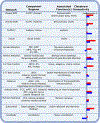A role for the claustrum in cognitive control
- PMID: 36192309
- PMCID: PMC9669149
- DOI: 10.1016/j.tics.2022.09.006
A role for the claustrum in cognitive control
Abstract
Early hypotheses of claustrum function were fueled by neuroanatomical data and yielded suggestions that the claustrum is involved in processes ranging from salience detection to multisensory integration for perceptual binding. While these hypotheses spurred useful investigations, incompatibilities inherent in these views must be reconciled to further conceptualize claustrum function amid a wealth of new data. Here, we review the varied models of claustrum function and synthesize them with developments in the field to produce a novel functional model: network instantiation in cognitive control (NICC). This model proposes that frontal cortices direct the claustrum to flexibly instantiate cortical networks to subserve cognitive control. We present literature support for this model and provide testable predictions arising from this conceptual framework.
Keywords: attention; cognition; cognitive network; cortex; cortical network; working memory.
Copyright © 2022 Elsevier Ltd. All rights reserved.
Conflict of interest statement
Declaration of interests F.S.B. is on the scientific advisory board for Wavepaths, Ltd. and a scientific advisor for Mindstate Design Labs, Inc.
Figures






Similar articles
-
The mouse claustrum synaptically connects cortical network motifs.Cell Rep. 2022 Dec 20;41(12):111860. doi: 10.1016/j.celrep.2022.111860. Cell Rep. 2022. PMID: 36543121 Free PMC article.
-
Involvement of the claustrum in the cortico-basal ganglia circuitry: connectional study in the non-human primate.Brain Struct Funct. 2024 Jun;229(5):1143-1164. doi: 10.1007/s00429-024-02784-6. Epub 2024 Apr 14. Brain Struct Funct. 2024. PMID: 38615290 Free PMC article.
-
Frontal cortical control of posterior sensory and association cortices through the claustrum.Brain Struct Funct. 2018 Jul;223(6):2999-3006. doi: 10.1007/s00429-018-1661-x. Epub 2018 Apr 6. Brain Struct Funct. 2018. PMID: 29623428 Free PMC article.
-
The Anatomy and Physiology of Claustrum-Cortex Interactions.Annu Rev Neurosci. 2020 Jul 8;43:231-247. doi: 10.1146/annurev-neuro-092519-101637. Epub 2020 Feb 21. Annu Rev Neurosci. 2020. PMID: 32084328 Review.
-
Human lesions and animal studies link the claustrum to perception, salience, sleep and pain.Brain. 2022 Jun 3;145(5):1610-1623. doi: 10.1093/brain/awac114. Brain. 2022. PMID: 35348621 Free PMC article.
Cited by
-
A simple and reliable method for claustrum localization across age in mice.Mol Brain. 2024 Feb 17;17(1):10. doi: 10.1186/s13041-024-01082-w. Mol Brain. 2024. PMID: 38368400 Free PMC article.
-
The spatial transcriptome of the late-stage embryonic and postnatal mouse brain reveals spatiotemporal molecular markers.Sci Rep. 2025 Apr 10;15(1):12299. doi: 10.1038/s41598-025-95496-8. Sci Rep. 2025. PMID: 40210990 Free PMC article.
-
Mapping common and distinct brain correlates among cognitive flexibility tasks: concordant evidence from meta-analyses.Brain Imaging Behav. 2025 Feb;19(1):50-71. doi: 10.1007/s11682-024-00921-7. Epub 2024 Oct 29. Brain Imaging Behav. 2025. PMID: 39467932 Free PMC article.
-
A comprehensive and reliable protocol for manual segmentation of the human claustrum using high-resolution MRI.Brain Struct Funct. 2025 Aug 13;230(7):134. doi: 10.1007/s00429-025-02993-7. Brain Struct Funct. 2025. PMID: 40801969
-
A Contrast-Agnostic Method for Ultra-High Resolution Claustrum Segmentation.Hum Brain Mapp. 2025 Aug 15;46(12):e70303. doi: 10.1002/hbm.70303. Hum Brain Mapp. 2025. PMID: 40838426 Free PMC article.
References
-
- Sadowski M et al. (1997) Rat’s claustrum shows two main cortico-related zones. Brain Res. 756, 147–152 - PubMed
Publication types
MeSH terms
Grants and funding
LinkOut - more resources
Full Text Sources

